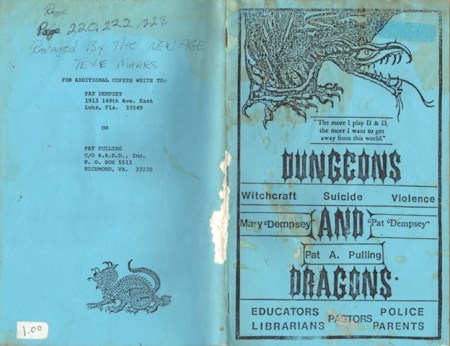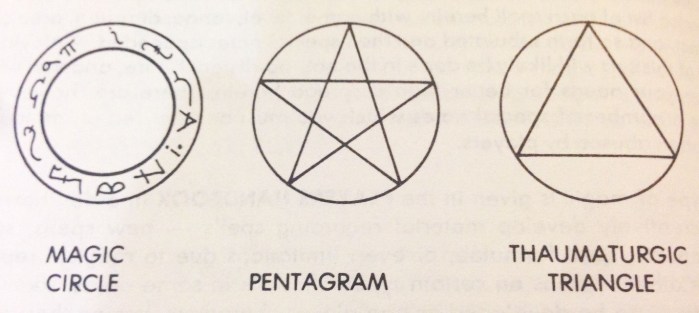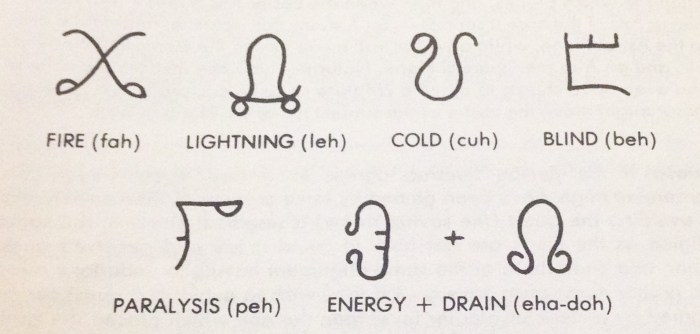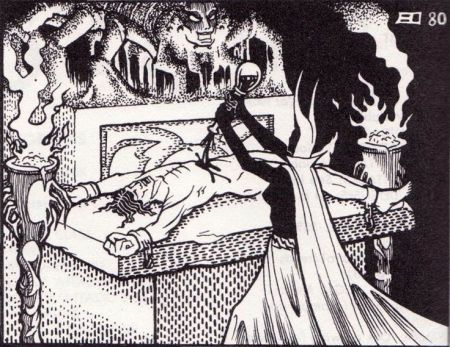By Michael M. Hughes / October 25, 2016
 If you’re like me, and you played Dungeons & Dragons in the ’70s and ‘80s, then you likely encountered someone who told you you were going to Hell. Maybe your born again aunt slipped you the infamous Jack Chick pamphlet, Dark Dungeons. Or maybe it was the kid in your class who broke your record player trying to convince you of the pervasiveness of Satanic messages in backward-masked heavy metal vocals. Perhaps your mom watched one of the televised exposés, like the shameful 60 Minutes segment from 1985, and fell for the hysterical propaganda from groups like Pat Pulling’s Bothered About Dungeons and Dragons (BADD), whose disciples warned that the game would turn you into a sociopathic, homosexual Satanist who would commit suicide after ritualistically killing your parents, your sister, and the family cat.
If you’re like me, and you played Dungeons & Dragons in the ’70s and ‘80s, then you likely encountered someone who told you you were going to Hell. Maybe your born again aunt slipped you the infamous Jack Chick pamphlet, Dark Dungeons. Or maybe it was the kid in your class who broke your record player trying to convince you of the pervasiveness of Satanic messages in backward-masked heavy metal vocals. Perhaps your mom watched one of the televised exposés, like the shameful 60 Minutes segment from 1985, and fell for the hysterical propaganda from groups like Pat Pulling’s Bothered About Dungeons and Dragons (BADD), whose disciples warned that the game would turn you into a sociopathic, homosexual Satanist who would commit suicide after ritualistically killing your parents, your sister, and the family cat.
Dungeons & Dragons was a major fuel of the satanic panic that convinced gullible Americans that their children were in danger of being indoctrinated into occultism, black magic, and witchcraft. Far too many people truly believed a game in which kids (and it was mostly kids) role-played wizards, warriors, and thieves hacking and slaying monsters with swords and magical spells in fantasy settings would turn the youth of America into black-robed, pagan ritualists. Crazy, right? Well, maybe not.

Anti-Dungeons & Dragons pamphlet published by Pat Pulling’s Bothered About Dungeons and Dragons (BADD), circa 1983
Confession time: I’m a practicing occultist. Not an armchair Crowleyite bedecked in Hot Topic jewelry or fluffy RenFaire Wiccan, but someone who has worked extensively with a number of practical magical systems. And if it hadn’t been for the magical education I got playing and DMing D&D as a kid, I probably wouldn’t have spent so much time reading about occultism before taking the plunge into actual practice about twenty years ago. And from informal surveys of my magician friends, D&D was definitely our gateway drug. So, in fact, that Jack Chick pamphlet was somewhat prophetic (although, I feel compelled to add, my brand of occultism does not involve harming anything or anyone, much less anything that could be remotely described as “evil”).
And although the opponents of D&D harped on mostly apocryphal psychological dangers (like sensitive kids committing suicide after the death of a beloved character), it was the magic and spells in the game that sent religious conservatives and evangelicals into paroxysms of panic. And understandably so, as the game featured not just the fireballs, lightning bolts, and healing potions of popular fantasy fiction, but necromancy, dark rituals, and demons and devils ripped from medieval grimoires. The tiny-print, hardback Advanced Dungeons & Dragons (AD&D) books included diagrams of magic circles, hierarchies of demons and devils, tables of medicinal plants (like something out of Cunningham’s Encyclopedia of Magical Herbs or Skinner’s The Complete Magician’s Tables), and ritual elements gleaned from historical and popular occultism.
AD&D’s magical lexicon was deep and rich, too. In the years before Gary Gygax, how many kids knew the meaning of words like thaumaturgy, thurible, and phylactery, much less folkloric concepts like the Irish geas and parapsychological terms like clairaudience and psionics? Where, in material aimed at kids, could you find descriptions of Neoplatonic elementals and diagrams of Blavatskian astral planes? Playing D&D was an introductory course in parapsychology, demonolatry, popular occultism, and western esotericism. And I devoured it—though the Christian fundamentalists, of course, would say it devoured me.
For an example, check out this demon summoning ritual, from the first edition Advanced Dungeons & Dragons Player’s Handbook (1978).
Cacodemon (Conjuration/Summoning)
The spell caster must be within a circle of protection (or a thaumaturgic triangle with protection from evil) and the demon confined within a pentagram (circled pentacle) if he or she is to avoid being slain or carried off by the summoned cacodemon.
The components of this spell are 5 flaming black candles; a brazier of hot coals upon which must be burned Sulphur, bat hairs, lard, soot, mercuric-nitric acid crystals, mandrake root, alcohol, and a piece of parchment with the demon’s name inscribed in runes inside a pentacle; and a dish of blood from some mammal (preferably a human, of course) placed inside the area where the cacodemon is to be held.
And then there were the gods. The game’s pantheon expanded with the publication of Deities & Demigods in 1980 (17 Pantheons of Divinities!), as did the number of illustrations of bare-breasted women in the AD&D core rulebooks—always appreciated by the game’s undersexed adolescent male fan base. The book was later retitled Legends & Lore in a futile attempt to placate fundamentalists, but the possibilities remained. Now campaigns could include the gods of Babylon, Egypt, the Celts, Greece, Rome, and Sumeria, among others—you could even roll with the Great Old Ones of H. P. Lovecraft’s Cthulhu mythos (until a lawsuit from Chaosium, which owned the gaming rights to Lovecraft’s material, forced their removal).
So when, in my 30s, I gave up trying to be a professional mentalist and began to explore the idea of trying out magic of the ceremonial variety, I discovered my D&D education had allowed me to test out of Magic 101. When I read Israel Regardie’s brick of a book, The Golden Dawn: The Original Account of the Teachings, Rites and Ceremonies of the Hermetic Order, I immediately saw it for what it was: the Player’s Handbook for real life magi, complete with instructions for creating talismans and ritual tools, using tarot cards for divination, and traveling the astral planes. Time to level up!
After a few years immersed in the Golden Dawn and its offshoots, I plunged soulfirst into the magic of the ancient Egyptians and Greeks (seeking the historical source code underlying all later systems) and found myself reciting orisons to gods I’d first met in Deities & Demigods. D&D taught me the practical benefits of polytheism (the more gods, the merrier), the importance of protective circles and banishings, and instilled a healthy respect for malign spiritual entities and the dregs of the astral’s unsavory neighborhoods.
So your born-again aunt was right. Jack Chick was right. D&D made me, and a lot of other nerdy spiritual seekers, into real-life magic users, clerics, and druids. We fell under D&D’s spell and failed our save versus magic. For me, a spiritually inclined kid prone to bouts of mysticism, D&D was the gateway to a world beyond the limits of my family’s mainstream, restrictive Catholicism. It helped me realize that the power of magic wasn’t confined to the priest standing behind the altar; I could light candles, burn incense, and invoke God (and gods) with just as much authority—and it’s just this spirit of independence and distrust of authority that informs so much of the occultist worldview.
If the Bible-bangers turn out to be right, though, I’m sure I’ll be seeing some of you in the Nine Hells. Don’t forget to bring your dice.













We who alternately went from rolling dice to donning black robes in the 1980s and 1990s, who lifted our athames and banishing daggers high, who filled our chalices with blood-red wine and our braziers with Dittany of Crete, thank you.
I loved your article. We didn’t all turn out to be occultists, or atheists, or bible thumpers, though I know some who went into all of these categories. Instead we used D&D to enhance our use of critical thought and to develop our personalities. We had a lot of fun developing our imaginations and spinning tales of adventure while other kids our age killed themselves with drugs and drink. I have nothing negative to say about D&D and BTW – I never go anywhere without my dice.
Oh, Deities and Demigods. Who remembers the one with the characters from Michael Moorcock’s novels? I loved the art in those first edition books so much.
I took the opposite tack. After reading DDG, I became an atheist. It took a few years before I realized all supernatural belief was nonsense, but that breakthrough was refreshing. Thanks, Gary Gygax!
Gary Gygax was a devout Christian. He was attacked mercilessly by ignorant fundamentalists relying on self-proclaimed experts who all turned out to be either deluded, outright frauds or both.
Pingback: Mainstream Mysticism: Doctor Strange Vs. Materialism | AKRON METAPHYSICAL
Pingback: Children of the Beast: The 1980s ‘Satanic Panic’
Pingback: Avalon Hill’s Occult Ritual Kits, 1974
Pingback: We Are All a Broken Family: The Hidden Terrors of ‘Bad Ronald’
I played AD&D when was a kid, my friends and I chose not to use deities and demigods, or play characters whose magic came from deities. Nothing bad happened, I am a devout member of my faith, and I still enjoy fantasy. Heck, I write fantasy, so all the terrible things I was told would happen to me never did.
Pingback: RPG, Films et Occultisme, comment la culture populaire initie la jeunesse à son insu
I’ve never played D&D, but I was wondering if D&D would be a useful way to explore/study the western occult tradition. Thanks for the article.
This occult game is an extremely dangerous gateway to being attacked by demons. My brother got caught up in this and was viciously attacked by demons. He said he thought he was going to die. I’m not lying. The game encourages spell casting and more dangerously conjuring of familiars which could be any level of actual demons -some are more powerful and destructive. Me and my parents were warned by the Holy Spirit to be ready to do spiritual warfare. And if you think this is a fantasy game -guess again. One day that powerful demon may come for you and no one will be there to help you. Just because you can’t see the air doesn’t mean it doesn’t exist and it lives in fantasy world in between your ears -it’s real. If you let the devil in, he’ll come in and do as much damage and destruction as he can and you’re going to get it when you least expect it. This isn’t a game. A
Thanks. Not only did I let the devil in, he drank all my beers and finished off an entire bag of Flamin’ Hot Cheetos.
Funny. My paladin/cleric character led to real apparitions & an real approved miracle in the Catholic Church.
AD&D 1st Edition led me to the real St. Cuthbert (of Lindesfarne) & he visited me once (gate miracle).
My Rosary turned gold (takes supernova power) & miraculous healings proofed what supernatural faith can do.
Occultists are the weakest of magic-users.
I tested my cleric power at 400,003rd level using raise water as a base test.
The Immaculate Heart of Mary triumphs over all.
I’ll pray the Rosary for your repentance & salvation.
I hold a D.S. in Electromagnetics/Electrical Engineering & a D. Min., Scripture, Dogmatics, & Spirituality.
It truly is about alignment, isn’t it?
Lawful Good.
Hail Mary.
Cool, man, congrats on the miracles! But no need to pray for me, I’m good. Chaotic Good, in fact. Never liked paladins and their know-it-all faux superiority, always thinking they know what’s right for everyone else. I respect others’ beliefs, as long as they’re not harming anyone.
And I’m a huge fan of Mary, and Jesus, too—seriously. I have a statue of Mary on my desk, in fact. Just not a fan of their so-called followers who spend more time judging and hating and feigning superiority than spreading love and being nice to those with different views and practices.
Party on!